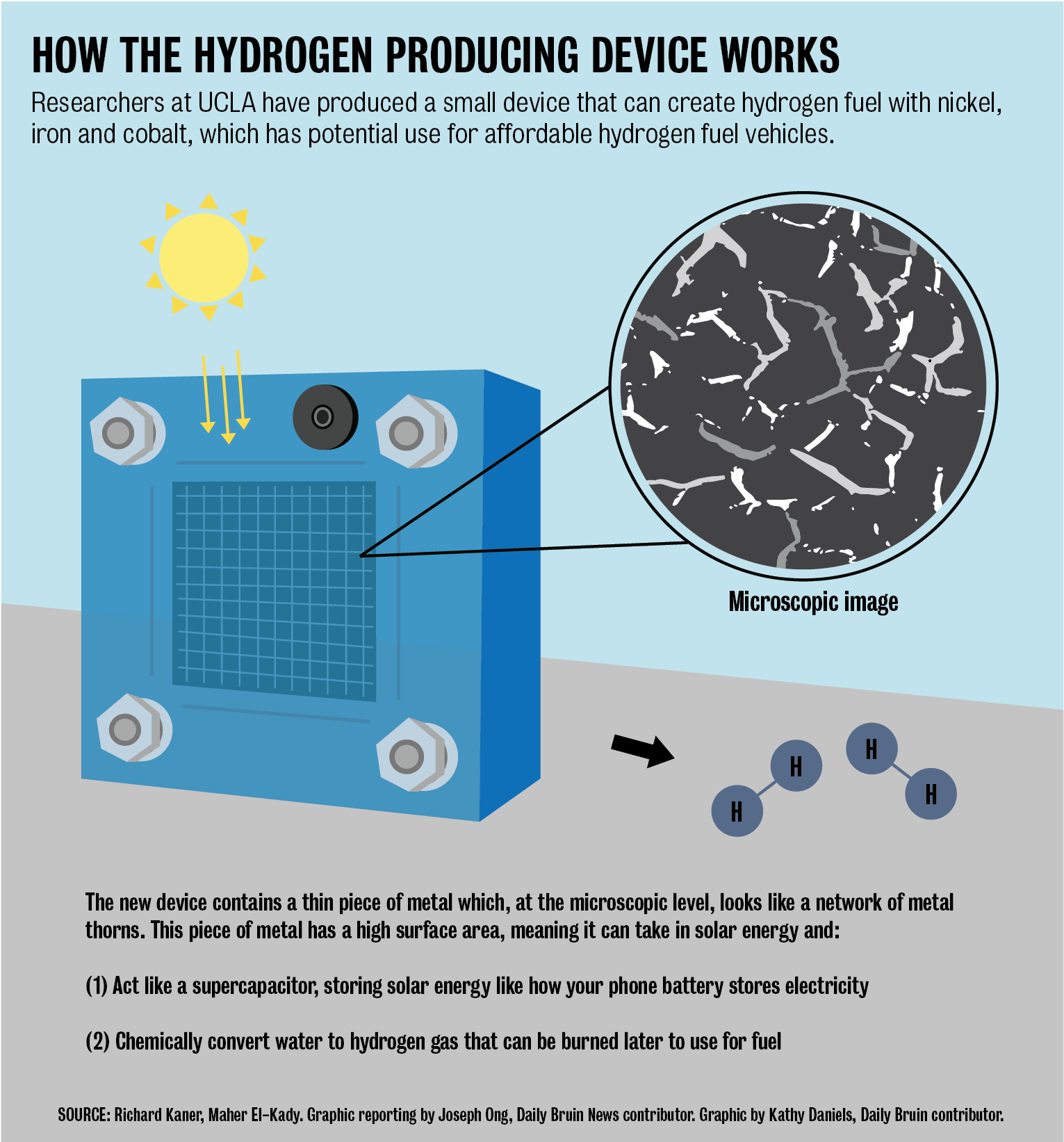UCLA researchers create device to make hydrogen more efficiently

By Joseph Ong
Nov. 29, 2017 10:45 p.m.
UCLA researchers have designed a device to efficiently store solar energy as hydrogen fuel.
In a study published in September, researchers led by Richard Kaner, a professor of chemistry and materials science, designed a device that uses solar energy to create hydrogen gas. The palm-sized device houses thin films of metal, which store solar energy like a battery or convert it to hydrogen for long-term storage. Hydrogen can be used as a source of energy to power machines like cars, said Maher El-Kady, a postdoctoral scholar in Kaner’s lab and an author on the study.
El-Kady said the sun provides a clean source of energy but can be unreliable during cloudy days or nighttime. The new device saves excess solar energy by storing it like a battery and can also extract hydrogen from water, he said.
El-Kady added hydrogen is an attractive energy source because, unlike fossil fuels, it produces no toxic byproducts such as carbon dioxide and pollutants. Hydrogen also contains more energy per gram than fossil fuels, he said.
However, scientists have struggled to find an efficient or affordable way of generating hydrogen from water, El-Kady said. Traditional approaches for producing hydrogen as a fuel rely on scarce and expensive metals like platinum to split water to make hydrogen gas.
El-Kady said he thinks their approach is more economical because they use a mix of common and cheaper metals containing iron, nickel and cobalt in their new device.
“What we’ve done is replace precious metals with earth-abundant metals,” he said.
The researchers electrochemically deposited the mix of metals onto a nickel foam to create the device, El-Kady said. The metals formed a network of thorn-like structures approximately ten thousand times smaller than a human hair.
This metallic network has a high surface area and exposes the reactive metal surface to water, splitting water into hydrogen more efficiently. Current methods using precious metals to produce hydrogen require two volts of energy, but the new device requires only one and a half volts, El-Kady said.
The metal network’s high surface area allows the device to act as a supercapacitor to store excess solar energy. Mit Muni, a graduate student in Kaner’s lab, said that because supercapacitors act like both a battery, which stores large amounts of energy, and a capacitor, which transfers that energy quickly, supercapacitors can both store and release large amounts of energy quickly.
Compared to traditional capacitors, the new device has a higher energy density, meaning it can hold more energy in one charge, and a higher power density, meaning it can use that charge more quickly, El-Kady said. This means new technologies, like a car powered by the new device, could travel farther and faster before needing to be recharged.
“(A useable device) needs high energy density and high power density,” El-Kady said. “Our device has both.”
El-Kady said the new device is also very durable because after 5000 cycles of charging and discharging, the device lost less than 9 percent of its capacity.
“After 500 cycles, (your phone battery) will drop to about 80 percent of its capacity,” El-Kady said. “(Our device) has more than 10 times the longevity than a lithium ion battery.”
Kaner said he thinks a larger-scale version of their device could help address real-world energy demands.
“If you invest the money, you could engineer a bigger device,” he said.
Kaner added that even if the device was made larger, engineers would have to find ways to transport and store hydrogen safely and efficiently before it could be used as a common energy source.
“To make technologies like hydrogen-powered cars a reality, you still need to be able to store hydrogen,” he said.
Storing and transporting hydrogen is difficult because hydrogen gas is stored under high pressures, El-Kady said.
“It’s not very safe,” El-Kady said. “We need to find a way to store hydrogen under normal temperature and pressure.”
El-Kady said he is hopeful for a hydrogen-powered future because their device is the first to store solar energy as both electricity and hydrogen for long-term use.
“This work is about the production of hydrogen,” El-Kady said. “We’re saving energy here.”

